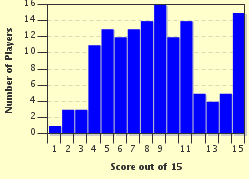Quiz Answer Key and Fun Facts
1. This member of the cucumber family has legs enabling it to walk. It does this by inflating or deflating cavities in the skin around the legs, using water. Their bodies are rather plump looking which is probably why they have gained their common name.
2. This insect is a member of the Mutillidae family which have hairy bodies. They have a range of colours and an extremely painful sting capable of knocking out a cow, giving rise to its alternative name of 'cow-killer'. Those that have a black and white colouration have an appropriate name.
3. This genus of octopus (Grimpoteuthis) gets its common name from the ear-like fins just above its eyes. I'm fairly sure it thinks it can fly.
4. This Asian crab is the largest in the world. It can weigh up to 42lb and has a leg span (claw to claw) of up to 12 feet. Strangely, it has ten legs.
5. This animal is the smallest member of the armadillo family. It lives in Argentina, feasting on ants and bugs that it finds underground. It is only about 4oz in weight, has large claws used for digging, and long silky hair protruding from under its rosy armour.
6. This mole is found in eastern Canada and the north-eastern United States. It has a rather unusual appearance. It has 11 pairs of short, fleshy tentacles on the end of its nose which are used to detect prey by means of their amazing sensitivity to nearby vibration.
7. This pink coloured shark has a long snout and jaws with long needle-like teeth below. The snout could get in the way of an effective bite but this shark can project its jaws forward. It's a real ugly customer that you wouldn't like to meet. Fortunately, it lives on the sea floor, feeding on crustaceans etc. It reminds me of an evil creature from the land of Tolkien's Misty Mountains.
8. Although called a snake, this animal is really an amphibian. It was thought to be extinct until it was rediscovered in Brazil in 2011. It is named after a part of the human body and to be honest, it isn't hard to see why.
9. This deep sea fish is the mascot of the Ugly Animal Preservation Society. One such animal had a talking part in the film "Men in Black 3".
10. This creature was not discovered until 2005. It is a ten-legged crustacean. Its most noticeable feature though is a fur-like covering over the front six legs (including claws). You might be forgiven for thinking it lives in mountainous areas rather than deep water.
11. This rather odd-looking fish is found at depths greater than about 100 feet in the general area of the Galapagos Islands. They 'walk' on the ocean floor using specially adapted fins but that isn't their most surprising feature. It is clearly a fan of waxy cosmetics (applied rather too generously).
12. This animal is a nocturnal primate found in Madagascar. It has very large eyes, a pointed face, teeth that grow continuously like a rodents, ears that are independently rotatable and hands with a very long clawed middle finger.
13. This fish has square, straight teeth rather like humans. They can be found in most of the rivers linked to the Amazon and are related to piranha but are much bigger. They are omnivorous and can grow to 55lb in weight.
14. This small insectivorous animal has black and yellow striped fur which gives it excellent camouflage when rooting around on the forest floor. It is said to look like a cross between a bumble bee and a hedgehog. About five inches long, it has a head with a narrow elongated nose surrounded by a crest of yellow detachable spines or quills which are also scattered amongst its fur.
15. This animal, alternate name pig-deer, looks basically like a wild pig as you would expect. Its head however is rather different. The lower canine teeth grow upward and are used as offensive weapons. The upper canine teeth of the males are different to say the least. They actually start growing downwards but then turn and grow upwards into the snout, emerging through the top and curve back towards the animal's forehead.
Source: Author
Spontini
This quiz was reviewed by FunTrivia editor
Tizzabelle before going online.
Any errors found in FunTrivia content are routinely corrected through our feedback system.


